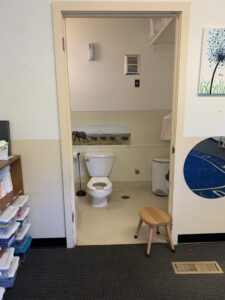
By Colleen Noll
At MSOSV, we will work with you and your child to look for signs of “readiness”. By partnering together when the time is right, following the MSOSV toilet learning plan can be a rewarding experience for both child and family.

Physical Readiness
Mental and Language Readiness
Emotional Readiness
In toilet learning, urination is often the focus; this is usually because it is a much harder skill to control liquids rather than mass. However, with many children, bowel movement control occurs much later. There are many individual factors that can contribute to this including physical, emotional, and mental readiness.

Bowel movement control often happens before urinary control. If they are regularly going to the toilet to urinate, chances are they may have a bowel movement while urinating.
It is for this reason that boys should preferably sit instead of stand during the first stages of toilet learning until they have mastered bowel movements. Every child is different in learning this skill; many children are aware of when they are having a BM but will often be shy in telling an adult or not know what to do. It is important to build up trust and reassure the child that everything is ok. Many children who are showing signs of readiness will want to ask questions and look at what is happening while you are changing their BM. It may be helpful to talk the child through what is happening in their bodies and include them in the process as much as possible.
Many children have Bowel Movements at the same time each day; this predictability can be used as a tool in helping the child succeed in BM control. Writing a chart of times, the child is likely to have a BM and looking for other signs (body posture and facial expression) can help signal that the child should sit on the toilet. It also helps chart the frequency of the child’s BMs, on occasion if the child is feeling anxious about passing BMs, they may hold them and become constipated.
In the morning or after nap, at wake time, have the child sit on the toilet after the diaper is removed from the night/nap. He/she is then put in training pants/underwear. During this time of Toilet Learning, pay attention to the activities you have planned. Be mindful and have a plan to use the toilet as needed or have the ability to use a restroom every 30 minutes. Once the child has entered the Toilet Learning process at school, parents are asked to avoid using a diaper for convenience.
When the child gets older and is efficient on the toilet, parents may still use plastic coverings over underpants when going out and might not be able to get to a toilet quickly. Consistently asking the child if they need to use the toilet. Parents are asked to sit the child on the toilet when they wake in the morning, before going anywhere outside of the home, before and after sleep time and after meals.

Asking nicely, and if they refuse say “You need to go to the toilet”. If they are comfortable with the toilet, they may refuse less often. Remember if they wet themselves, it is okay. Just reinforce to them verbally that they need to pee in the toilet. If the child is dry for extended periods of time and goes to the toilet on a frequent basis this can be time to move on to the toilet learning process and say bye-bye to the diaper.
There should be no pressure put on children to be toilet independent. Toilet learning is a natural process and should be done at a pace the child is comfortable with. Allowing children to become aware of their bodily functions from the sensitive period of development allows for less distress when the child is older and more physically able to control their toileting abilities. Please remember although the child is wetting in their underwear, they are not ‘failing’ at toileting rather, they are learning the sensation and the need to go. They are beginning to feel and not appreciate the discomfort of having wet underwear. This is part of the learning process that is Toilet Learning.